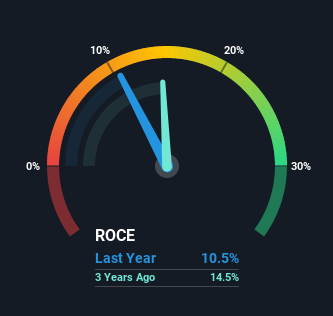Returns On Capital At TClarke (LON:CTO) Have Stalled
If we want to find a potential multi-bagger, often there are underlying trends that can provide clues. Amongst other things, we'll want to see two things; firstly, a growing return on capital employed (ROCE) and secondly, an expansion in the company's amount of capital employed. Ultimately, this demonstrates that it's a business that is reinvesting profits at increasing rates of return. So, when we ran our eye over TClarke's (LON:CTO) trend of ROCE, we liked what we saw.
What is Return On Capital Employed (ROCE)?
If you haven't worked with ROCE before, it measures the 'return' (pre-tax profit) a company generates from capital employed in its business. The formula for this calculation on TClarke is:
Return on Capital Employed = Earnings Before Interest and Tax (EBIT) ÷ (Total Assets - Current Liabilities)
0.10 = UK£5.3m ÷ (UK£146m - UK£95m) (Based on the trailing twelve months to December 2020).
Therefore, TClarke has an ROCE of 10%. That's a relatively normal return on capital, and it's around the 11% generated by the Construction industry.
Check out our latest analysis for TClarke
Above you can see how the current ROCE for TClarke compares to its prior returns on capital, but there's only so much you can tell from the past. If you'd like to see what analysts are forecasting going forward, you should check out our free report for TClarke.
What Does the ROCE Trend For TClarke Tell Us?
While the current returns on capital are decent, they haven't changed much. The company has consistently earned 10% for the last five years, and the capital employed within the business has risen 33% in that time. Since 10% is a moderate ROCE though, it's good to see a business can continue to reinvest at these decent rates of return. Over long periods of time, returns like these might not be too exciting, but with consistency they can pay off in terms of share price returns.
On a separate but related note, it's important to know that TClarke has a current liabilities to total assets ratio of 65%, which we'd consider pretty high. This can bring about some risks because the company is basically operating with a rather large reliance on its suppliers or other sorts of short-term creditors. Ideally we'd like to see this reduce as that would mean fewer obligations bearing risks.
The Bottom Line On TClarke's ROCE
The main thing to remember is that TClarke has proven its ability to continually reinvest at respectable rates of return. And long term investors would be thrilled with the 111% return they've received over the last five years. So while investors seem to be recognizing these promising trends, we still believe the stock deserves further research.
Like most companies, TClarke does come with some risks, and we've found 6 warning signs that you should be aware of.
If you want to search for solid companies with great earnings, check out this free list of companies with good balance sheets and impressive returns on equity.
This article by Simply Wall St is general in nature. It does not constitute a recommendation to buy or sell any stock, and does not take account of your objectives, or your financial situation. We aim to bring you long-term focused analysis driven by fundamental data. Note that our analysis may not factor in the latest price-sensitive company announcements or qualitative material. Simply Wall St has no position in any stocks mentioned.
Have feedback on this article? Concerned about the content? Get in touch with us directly. Alternatively, email editorial-team (at) simplywallst.com.

